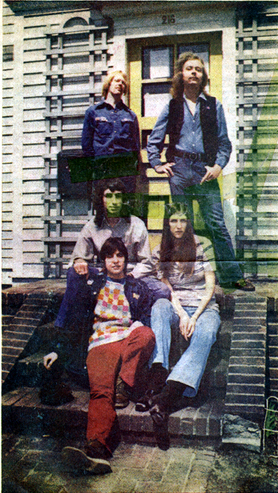Gay House
216 Ridgewood Avenue, 4th Ave. S and 22nd St., 4419 Nicollet Avenue S. (1971-1979?)
| Gay House is a place of genesis for contemporary queer life in Minnesota. Several organizations began here, including OutFront Minnesota, the Twin Cities Pride Festival, the All God's Children MCC, and the Lesbian Resource Center, as did several individuals, including Jack Baker (of Baker Law Associates, Jean-Nickolaus Tretter (of the Jean-Nickolaus Tretter Collection, and Steve Endean—who served on Gay House’s Board of directors before beginning the Human Rights Campaign in Washington D.C.(1)
|
 Gay House at its Ridgewood address: (Sitting) Mike McConnell, Lena Hardin and Cynthia Hanson; (Standing) Darrel Johnson, left, and David Christian. Photo by John Croft of the Minneapolis Tribune. Courtesy of the Jean-Nickolaus Tretter Collection. |
The discussions (or “rap sessions”) inspired equal amounts of genuine synergy and scandalous infighting—a dissatisfied participant complained “the house was basically run by kids above 18 for kids below 18.”(4) The young pioneers—who considered themselves part of a brotherhood and sisterhood—worked without a model organization long before standards of queer professionalism existed. Thus, meetings occasionally devolved into a series of “loud, angry, and seemingly pointed requests…for participation in some activities.”
Volunteers at the community service center received 50,000 phone calls and provided counseling services to well over 5,000 by 1975.(5) Four years later, the inappropriate sexual behavior of some counselors contributed to existing financial and interpersonal issues—the center closed by 1980.
This entry is part of:
Minneapolis/St. Paul, MN: 100 Queer Places in Minnesota History, (1860-2010)
(1)Endean, Steve ed. Eaklor, Viki Lynn. Bringing Lesbian and Gay Rights into the Mainstream: Twenty Years of Progress. Binghamton, NY: Haworth Press, 2006. Page 11.
(2)Barbara Gittings Letter, OutFront Minnesota Collection, Box 1. Tretter Collection in GLBT Studies.
(3)Preston, John. "Winter's Light: Reflections of a Yankee Queer." Hanover, N.H.: University Press of New England, 1995. Page 23.
(4)“Open House-Meeting at Gayhouse [sic]” Hundred Flowers, 10/1/71. Page 11.
(5)“Gay House Starts Fifth Years of Service.” Gay House Newsletter, 7/14/75.